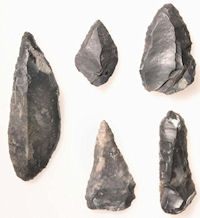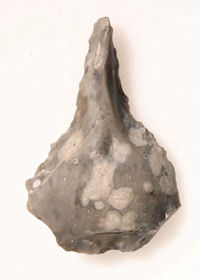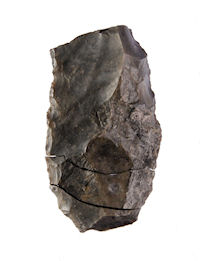
Figure 3: Exotic flint of 'Michelsberg signature' from the wetland site of Schipluiden (photograph B. Grishaver, Leiden University)
During the period of the Hazendonk group, dating to roughly 3700-3400 BC (Middle Neolithic A and contemporaneous with the later Michelsberg culture), exotic mined flint tools continue to be brought to the wetlands. We find a large number of them in the well-researched micro-region of Delfland, situated close to the present-day town of The Hague, at the sites of Wateringen 4, Schipluiden and Ypenburg (Raemaekers et al. 1997; Van Gijn et al. 2006; Van Gijn and Verbaas 2008).

Figure 3: Exotic flint of 'Michelsberg signature' from the wetland site of Schipluiden (photograph B. Grishaver, Leiden University)
On a large dune surrounded by marshland, four concentrations of finds were discovered, interpreted as households that persisted for around two centuries (3600-3400 BC) (Louwe Kooijmans and Jongste 2006). Again, we see the importation of macrolithic tools of southern flint (Fig. 3). These imported implements have a very clear Michelsberg signature. In contrast to such tools at the earlier site of Brandwijk, however, they seem to have been imported in an unused state, probably as finished implements, although we do find occasional production waste of exotic flint. They are all subsequently heavily used and frequently display traces of rejuvenation. Moreover, the pattern of their use reveals connections with specific activities, tasks that may have been accorded a particular cultural significance in prehistory.

Figure 4: Schipluiden: borer of southern flint, most likely used to drill jet (photograph B. Grishaver, Leiden University)
These tasks included working jet and amber ornaments, making fire and harvesting cereals. Many of the flint tools used on mineral substances like amber and jet are of southern origin, like a large reamer of grey mottled flint that may be sourced to Avennes in southern Belgium (Fig. 4). Ornament making can be seen as special because beads and pendants of amber and jet were given to the dead, as evidenced by the cemetery of Ypenburg (Fig. 5) (Koot 2005; Koot et al. 2008; Van Gijn 2008b).
Another arguably 'special' activity is the making of fire. A large number of strike-a-lights was found, most of which were produced on southern imported flint (Fig. 6). These tools must have been used for an extensive period of time, considering the extent of wear they display. The special significance of this tool is indicated by their presence in a remarkable grave excavated within the settlement area of Schipluiden (Louwe Kooijmans and Smits 2006; Van Gijn et al. 2006). Three strike-a-lights and a piece of pyrite were found in the hand of a dead adult male at Schipluiden. The hand holding the fire-making toolkit was situated close to the mouth, evoking the image of someone blowing a spark. This individual was given such an unusual burial ritual compared to other burials at this site and at the nearby cemetery of Ypenburg, that he must be regarded as a person with a special role or position in society. Because of the presence of a fire-making tool kit in his hand, I would argue that he may have been a religious specialist, maybe akin to present-day shamans. This special set of burial gifts thus provides us with a glimpse of the ideology of the inhabitants: it indicates the importance of fire and suggests that the person buried there had something to do with the use of fire.

Figure 6: Schipluiden: strike-a-lights and a nodule of pyrite (photograph B. Grishaver, Leiden University)
The third potentially special activity with which exotic flint tools were closely associated was the harvesting of cereals. The special significance of cereal harvesting is underlined by the evidence that implements involved in this activity seem to have undergone very special treatment prior to deposition. After they had been used for harvesting, the sickles were first burned, after which, their functional edges were destroyed by intentional flaking. As a final act, these edges were then rubbed with a red substance that looks like ochre (though this is still to be analysed). Several sickles from Ypenburg also display this sequence of treatment (Fig. 7). This singular, highly ritualised, attention paid to harvesting tools indicates that they held a special significance to people at the time, an attention that is echoed elsewhere. The deliberate destruction of agricultural tools once their use-life was over has also been demonstrated for the Early Neolithic querns of the Dutch Bandkeramik. These were deliberately fractured after their use-life ended (sometimes long before the quern was completely worn out) and rubbed with ochre. There are, however, no signs of burning (Verbaas and Van Gijn 2007). Because use-wear analysts have long dismissed burned flint as being unsuitable for use-wear analysis, many burned cereal harvesting tools may have been missed in the past.

Figure 7: Ypenburg: imported flint used to harvest cereals and subsequently burned, broken and rubbed with ochre (photograph Q. Bourgois, Leiden)
All of the imported tools of southern flint at the Hazendonk sites of Schipluiden and Ypenburg were used intensively, were resharpened and did not display traces that could be considered 'foreign'. That is, they had never been used for typical Michelsberg activities like intensive hide scraping or the activity responsible for the development of 'polish 10'. This is a different sort of behaviour from the preceding southern Swifterbant culture, exemplified by the site of Brandwijk, and indicates a change in attitude towards the Michelsberg farmers in the south-east: Hazendonk agents apparently no longer just kept Michelsberg implements as a gift or token of their allegiance to the larger Michelsberg identity sphere, but actually appropriated them and gave them a place in their own technological system (sensu Lemonnier 1986).
© Internet Archaeology/Author(s) URL: http://intarch.ac.uk/journal/issue26/35/2.2.html
Last updated: Wed Jul 29 2009